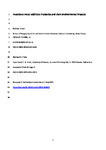Hazardous metal additives in plastics and their environmental impacts
| dc.contributor.author | Turner, Andrew | |
| dc.contributor.author | Filella, M | |
| dc.date.accessioned | 2021-08-10T08:45:47Z | |
| dc.date.issued | 2021-11 | |
| dc.identifier.issn | 0160-4120 | |
| dc.identifier.issn | 1873-6750 | |
| dc.identifier.other | 106622 | |
| dc.identifier.uri | http://hdl.handle.net/10026.1/17539 | |
| dc.description.abstract |
Historically, many additives and catalysts used in plastics were based on compounds of toxic metals (and metalloids), like arsenic, cadmium, chromium(VI), and lead. Despite subsequent restrictions, hazardous additives remain in plastics in societal circulation because of the pervasiveness of many products and the more general contamination of recycled goods. However, little is understood about their presence and impacts in the environment, with most studies focusing on the role of plastics in acquiring metals from their surroundings through, for example, adsorption. Accordingly, this paper provides a review of the uses of hazardous, metal-based additives in plastics, the relevant European regulations that have been introduced to restrict or prohibit usage in various sectors, and the likely environmental impacts of hazardous additives once plastics are lost in nature. Examination of the literature reveals widespread occurrence of hazardous metals in environmental plastics, with impacts ranging from contamination of the waste stream to increasing the density and settling rates of material in aquatic systems. A potential concern from an ecotoxicological perspective is the diffusion of metals from the matrix of micro- and nanoplastics under certain physico-chemical conditions, and especially favorable here are the acidic environments encountered in the digestive tract of many animals (birds, fish, mammals) that inadvertently consume plastics. For instance, in vitro studies have shown that the mobilization of Cd and Pb from historical microplastics can greatly exceed concentrations deemed to be safe according to migration limits specified by the current European Toy Safety Directive (17 mg kg-1 and 23 mg kg-1, respectively). When compared with concentrations of metals typically adsorbed to plastics from the environment, the risks from pervasive, historical additives are far more significant. | |
| dc.format.extent | 0-0 | |
| dc.format.medium | Print-Electronic | |
| dc.language | en | |
| dc.language.iso | en | |
| dc.publisher | Elsevier BV | |
| dc.subject | Plastics | |
| dc.subject | Hazardous additives | |
| dc.subject | Metals | |
| dc.subject | Regulations | |
| dc.subject | Recycling | |
| dc.subject | Environmental impacts | |
| dc.title | Hazardous metal additives in plastics and their environmental impacts | |
| dc.type | journal-article | |
| dc.type | Journal Article | |
| dc.type | Review | |
| plymouth.author-url | https://www.webofscience.com/api/gateway?GWVersion=2&SrcApp=PARTNER_APP&SrcAuth=LinksAMR&KeyUT=WOS:000685626800010&DestLinkType=FullRecord&DestApp=ALL_WOS&UsrCustomerID=11bb513d99f797142bcfeffcc58ea008 | |
| plymouth.volume | 156 | |
| plymouth.publication-status | Published | |
| plymouth.journal | Environment International | |
| dc.identifier.doi | 10.1016/j.envint.2021.106622 | |
| plymouth.organisational-group | /Plymouth | |
| plymouth.organisational-group | /Plymouth/Faculty of Science and Engineering | |
| plymouth.organisational-group | /Plymouth/Faculty of Science and Engineering/School of Geography, Earth and Environmental Sciences | |
| plymouth.organisational-group | /Plymouth/REF 2021 Researchers by UoA | |
| plymouth.organisational-group | /Plymouth/REF 2021 Researchers by UoA/UoA07 Earth Systems and Environmental Sciences | |
| plymouth.organisational-group | /Plymouth/Research Groups | |
| plymouth.organisational-group | /Plymouth/Research Groups/BEACh | |
| plymouth.organisational-group | /Plymouth/Research Groups/Marine Institute | |
| plymouth.organisational-group | /Plymouth/Users by role | |
| plymouth.organisational-group | /Plymouth/Users by role/Academics | |
| dc.publisher.place | Netherlands | |
| dcterms.dateAccepted | 2021-05-01 | |
| dc.rights.embargodate | 2021-8-13 | |
| dc.identifier.eissn | 1873-6750 | |
| dc.rights.embargoperiod | Not known | |
| rioxxterms.versionofrecord | 10.1016/j.envint.2021.106622 | |
| rioxxterms.licenseref.uri | http://www.rioxx.net/licenses/all-rights-reserved | |
| rioxxterms.licenseref.startdate | 2021-11 | |
| rioxxterms.type | Journal Article/Review |


